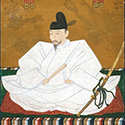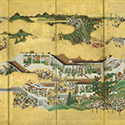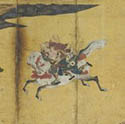|
|
| Show All 30 Results (Text Only) |
|
| The Kitano Tenjin Engi Emaki |
|
| The Metropolitan Museum of Art
|
A multimedia learning website about a 13th-century Japanese handscroll that illustrates the legends of the Kitano Shrine (Kitano Tenjin Engi). Included are a short introduction to the Kitano Tenjin Engi Emaki and audio introduction to the pieces.
Go to Museum Resource: https://www.metmuseum.org/art/collection/search/45428 | |
|
|
|
| Muromachi Period (1392–1573) |
|
| The Metropolitan Museum of Art
|
A brief overview of cultural and artistic developments during the Muromachi period, when members of the Ashikaga family occupied the position of shogun. The Muromachi era was characterized by social and political upheaval, but it was also a time of economic and artistic innovation. With 6 related artworks.
Go to Museum Resource: http://www.metmuseum.org/toah/hd/muro/hd_muro.htm | |
|
|
|
|
|
| Samurai Warrior Codes: Comparing Perspectives from the Kamakura, Muromachi, and Edo Periods |
|
| Asian Art Museum of San Francisco
|
The term, bushido, is often used to describe the samurai warrior code during medieval and modern times. The definition refers to a late 19th century description and was actually quite different than codes from earlier times. Compare warrior codes from different times with the modern definition of bushido. Then, choose which code you think matches the samurai in the screen painting, the Battles at Ichi-no-tani and Yashima, from The Tale of the Heike. Downloads include a Lesson Plan, slide show, and Student Handout.
Go to Museum Resource: https://education.asianart.org/resources/samurai-warrior-codes-comparing-perspe... | |
|
|
| Samurai War Tales: Battle of Awazugahara, from The Tale of the Heike |
|
| Asian Art Museum of San Francisco
|
Based on real events from the 900s to 1600s and then embellished over time to create powerful narratives full of good storytelling, sympathetic characters, and poignant and stirring events, War Tales provide information and insights into the lives of Japans warriors. The Tale of the Heike is among Japan’s most celebrated war tales. It traces the rise, brief glory, and fall of the Taira clan (also known as the Heike clan). “This scene illustrates an episode from the chapter 'The End of the Life of Kiso Yoshinaka' in The Tale of the Heike, a thirteenth-century recounting of the wars between two powerful clans, the Heike and the Genji (also called the Taira and the Minamoto).” Also see the video “The Samurai and the Storyteller” and Battles at Ichi-no-tani and Yashima.
Go to Museum Resource: https://education.asianart.org/resources/battle-of-awazugahara-from-the-tale-of... | |
|
|
|
| Show All 30 Results (Text Only) |









